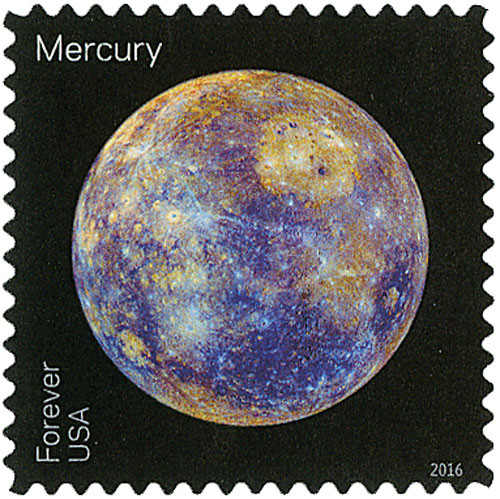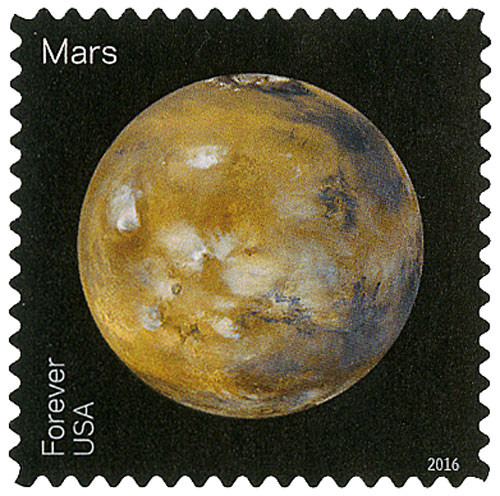
# 5071 - 2016 First-Class Forever Stamp - Views of Our Planets: Earth
US #5071
2016 Earth – Views of Our Planets
- Pictures Earth, the third planet from the Sun
- One of 8 stamps issued alongside the 2016 Pluto Explored stamps to commemorate space exploration in our Solar System and New Horizon spacecraft’s flyby of Pluton in 2015
Stamp Category: Commemorative
Set: Views of Our Planets
Value: 47¢ First Class Mail Rate (Forever)
First Day of Issue: May 31, 2016
First Day City: New York, New York
Quantity Issued: 40,000,000
Printed by: Ashton Potter (USA) Ltd.
Printing Method: Offset
Format: Panes of 16
Tagging: Nonphosphored type III, spot tag
Why the stamp was issued: To showcase Earth, the third planet from the Sun, and the NASA efforts that have allowed us to see this planet up-close. To honor NASA’s space exploration efforts within our Solar System that have given us up-close images of every plant and – as of 2015 – dwarf planet Pluto.
About the stamp designs: Pictures an image of Earth from NASA.
First Day City: The First Day of Issue Ceremony was held at the Javits Center in New York City during the World Stamp Show 2016.
About the Views of Our Planets set: Eight stamps issued to honor NASA’s space exploration efforts within our Solar System that have given us up-close images of every planet and – as of 2015 – dwarf planet Pluto. Each stamp pictures one planet in our Solar System. According to the USPS, “Some show the planet’s ‘true’ color – what we might see with our own eyes if traveling through space. Others use colors to represent and visualize certain features of a planet based on imaging data. Still others use the near-infrared spectrum to show things that cannot be seen by the human eye in visible light.”
History the stamp represents: Earth is the only planet in our solar system not named for a Greek or Roman deity. Used to describe our planet for at least 1,000 years, Earth comes from the Old English and German words for “ground.”
That ground is part of what is known as the lithosphere. It is comprised of Earth’s crust and upper mantle, which are divided into massive plates that are constantly moving at a rate of about three to four inches per year. The edges of these plates are frequent hosts for earthquakes, volcanic activity, and mountain ranges.
Above the lithosphere lays Earth’s atmosphere, which is an important element to sustaining life on this planet. The atmosphere protects us from the cold airlessness of space. It also keeps out radiation from the Sun and burns up most meteors before they can hit the surface. It also helps the planet retain its water, which is crucial to our survival.
The atmosphere and lithosphere, as well as the hydrosphere, cryosphere, and biosphere, are all part of the complex system that enables life on Earth. In recent years, NASA has undertaken new missions to explore how natural and human-induced changes affect the Earth so it can continue to provide all life with a suitable home.
US #5071
2016 Earth – Views of Our Planets
- Pictures Earth, the third planet from the Sun
- One of 8 stamps issued alongside the 2016 Pluto Explored stamps to commemorate space exploration in our Solar System and New Horizon spacecraft’s flyby of Pluton in 2015
Stamp Category: Commemorative
Set: Views of Our Planets
Value: 47¢ First Class Mail Rate (Forever)
First Day of Issue: May 31, 2016
First Day City: New York, New York
Quantity Issued: 40,000,000
Printed by: Ashton Potter (USA) Ltd.
Printing Method: Offset
Format: Panes of 16
Tagging: Nonphosphored type III, spot tag
Why the stamp was issued: To showcase Earth, the third planet from the Sun, and the NASA efforts that have allowed us to see this planet up-close. To honor NASA’s space exploration efforts within our Solar System that have given us up-close images of every plant and – as of 2015 – dwarf planet Pluto.
About the stamp designs: Pictures an image of Earth from NASA.
First Day City: The First Day of Issue Ceremony was held at the Javits Center in New York City during the World Stamp Show 2016.
About the Views of Our Planets set: Eight stamps issued to honor NASA’s space exploration efforts within our Solar System that have given us up-close images of every planet and – as of 2015 – dwarf planet Pluto. Each stamp pictures one planet in our Solar System. According to the USPS, “Some show the planet’s ‘true’ color – what we might see with our own eyes if traveling through space. Others use colors to represent and visualize certain features of a planet based on imaging data. Still others use the near-infrared spectrum to show things that cannot be seen by the human eye in visible light.”
History the stamp represents: Earth is the only planet in our solar system not named for a Greek or Roman deity. Used to describe our planet for at least 1,000 years, Earth comes from the Old English and German words for “ground.”
That ground is part of what is known as the lithosphere. It is comprised of Earth’s crust and upper mantle, which are divided into massive plates that are constantly moving at a rate of about three to four inches per year. The edges of these plates are frequent hosts for earthquakes, volcanic activity, and mountain ranges.
Above the lithosphere lays Earth’s atmosphere, which is an important element to sustaining life on this planet. The atmosphere protects us from the cold airlessness of space. It also keeps out radiation from the Sun and burns up most meteors before they can hit the surface. It also helps the planet retain its water, which is crucial to our survival.
The atmosphere and lithosphere, as well as the hydrosphere, cryosphere, and biosphere, are all part of the complex system that enables life on Earth. In recent years, NASA has undertaken new missions to explore how natural and human-induced changes affect the Earth so it can continue to provide all life with a suitable home.











